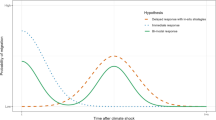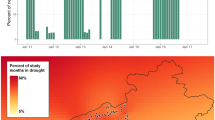Abstract
While evidence on the linkages between migration and climate is starting to emerge, the subject remains largely under-researched at regional scale. Knowledge on the matter is particularly important for Northern Latin America and the Caribbean, a region of the world characterized by exceptionally high migration rates and substantial exposure to natural hazards. We link individual-level information from multiple censuses for eight countries in the region with natural disaster indicators constructed from georeferenced climate data at the province level to measure the impact of droughts and hurricanes on internal mobility. We find that younger individuals are more likely to migrate in response to these disasters, especially when confronted with droughts. Youth exhibit a stronger inclination towards relocating to rural and small town settings, motivated possibly by opportunities for nearby off-farm employment and financing limitations for urban transport and living expenses. Migration decisions are mediated by national institutional arrangements. These findings highlight the importance of social protection and regional planning policies to reduce the vulnerability of youth to droughts in the future and secure their economic integration.


Similar content being viewed by others
Notes
The trade-off in using national census data is that we are likely to underestimate the scale of environmental displacement due to the absence of reporting within-province and international moves. However, international migration is less common due to the mobility costs, language requirements, and uncertainty of receiving employment at the destination (Deshingkar and Grimm 2005). On the contrary, short-distance moves are often most responsive to changes in the environment (Fussell et al. 2014). Our estimates are therefore likely to provide a lower bound of the true effects of disasters on environmental migration.
The censuses allow for measurement of migration over a 5-year window. They do not provide the exact year each person moved.
We shorten the frame of reference of historical rainfall and temperature to 20 years, with the assumption that recent trends are more likely to influence the behavior of our relatively young sample.
Daily rainfall during the hurricane is considered a significant predictor of hurricanes in the region (Palmieri et al. 2006). This is one motivation for using the TRMM data product which provides daily rainfall data relative to the CRUTS data which we use to measure historical precipitation trends and droughts (detailed later). Data on wind and storm surges at a fine resolution over time were unavailable, which precluded the computation of exposure measures using additional parameters (e.g., as in Logan and Xu 2015).
The scale of exposure is limited to the province because the censuses report the origin of migrants at that level. All 132 provinces are included in our study, with the average size of 50,733 km2.
The distribution of the hurricane intensity variable is provided in the Supplementary Material.
The distribution of the drought intensity variable is provided in the Supplementary Material.
The traditional difference-in-difference approach has been used in a variety of disciplines to measure the health consequences of disasters (Datar et al. 2013; Grabich et al. 2015). Disaster typically is a binary variable in which indicates whether the province is exposed to the event. We adopt a continuous version of the variable, by quantifying the intensity of the disaster in the provinces exposed to the event.
Since the Disaster variable varies at the province level and the After variable varies by year, we do not explicitly need to control for the interacted variables on their own when including origin province and census year fixed effects. A simple double difference model shows positive migration effects attributable to both droughts and hurricanes (Supplementary Material).
We estimate the regression results, varying the exposure reference to the migration recall period (5 years) and the migration recall period plus an additional year prior. Both produce similar migration impact estimates (Supplementary Material). Our inability to observe the precise timing of the move is a limitation of the study. For a fraction of the migrant sample, exposure might occur after they have moved. Conditional on the spatial and destination fixed effects and the time-varying historical weather averages, we would expect these moves to have zero correlation with the hurricane or drought intensity variables. Because we are measuring the average effect on the sample, we might expect this to put downward pressure on our positive effects. Thus, in the worst case scenario, our results are likely a lower bound estimate of the true impact.
The preponderance of youth in the migrant population has been widely established in the 2007 World Development Report (World Bank. World Development Report 2007).
Estimates of all coefficients in these regressions, save the province fixed effects, are presented in the Supplementary Material. Bootstrapping results indicate the results are robust when the sample size is reduced to 10% (Supplementary Material). We do not witness any obvious nonlinear effects when categorizing the hurricane intensity variables into binary variables that reflect whether the intensity value lies between 0 and 1, 1 and 2, and greater than 2 standard deviations (Supplementary Material). The impacts of droughts on youth migration are much larger for extreme values of intensity, however.
To give perspective of the scope of environmental migration, the estimates in Specifications B and D suggest that (16,724,006 × 0.35 × 0.0071=) 41,559 and (16,724,006 × 0.35 × 0.0027=) 15,084 more 15–25-year olds in the region would migrate across provinces in response to a 1 standard deviation increase in drought and hurricane intensity, respectively. An additional (16,724,006 × 0.24 × 0.0029=)11,639 26–35-year olds would also move under the same change in hurricane exposure.
Geolocation codes needed to define provincial and country capitals are not provided for Jamaica. We therefore omit all 14 provinces from Jamaica from the analysis in Table 4, as we are unable to identify the provincial capitals.
References
Acosta P (2011) School attendance, child labor, and remittances from international migration in El Salvador. J Dev Stud 47(6):913–936
Akresh R, Lucchetti L, Thirumurthy H (2012) Wars and child health: evidence from the Eritrean Ethiopian conflict. J Dev Econ 99(2):330–340
Almond D, Mazumder B (2005) The 1918 influenza pandemic and subsequent health outcomes: an analysis of SIPP data. Am Econ Rev 95(2):258–262
Barham B, Boucher S (1998) Migration remittances and inequality: estimating the net effect of migration on income distribution. J Dev Econ 55:307–331
Barrett C, Constas M (2014) Toward a theory of resilience for international development applications. Proc Natl Acad Sci 111(40):14625–14630
Bashir S, Gindling TH, Oviedo A (2012) Better jobs in Central America: the role of human capital. World Bank
Bohra-Mishra P, Oppenheimer M, Hsiang S (2014) Nonlinear permanent migration response to climatic variations but minimal response to disasters. Proc Natl Acad Sci 111(29):9780–9785
Carter M, Little P, Mogues T, Negatu W (2007) Poverty traps and natural disasters in Ethiopia and Honduras. World Dev 35(5):835–856
Caruso G, Miller S (2015) Long run effects and intergenerational transmission of natural disasters: a case study on the 1970 Ancash Earthquake. J Dev Econ 117:134–150
Center for International Earth Science Information Network (CIESIN) Columbia University, International Food Policy Research Institute—IFPRI, The World Bank, and Centro Internacional de Agricultura Tropical—CIAT (2011) Global Rural-Urban Mapping Project, Version 1 (GRUMPv1): population count grid. Palisades, NY: NASA Socioeconomic Data and Applications Center (SEDAC). doi: 10.7927/H4VT1Q1H. Accessed June 30, 2015
Datar A, Liu J, Linnemayr S, Stecher C (2013) The impact of natural disasters on child health investments in Rural India. Soc Sci Med 76(1):83–91
De Janvry A, Finan F, Sadoulet E, Vakis R (2006) Can conditional cash transfer programs serve as safety nets in keeping children at school and from working when exposed to shocks? J Dev Econ 79:349–373
Deshingkar P, Grimm S (2005) Internal migration and development: a global perspective. International Organization of Migration Research Series No. 19
Dilley M et al (2005) Natural disaster hotspots: a global risk analysis. World Bank
EM-DAT (2015) The International Disaster Database. Centre for Research on the Epidemiology of Disasters-CRED. Accessed online November 24, 2015: http://www.emdat.be/
Feng S, Krueger A, Oppenheimer M (2010) Linkages among Climate Change. Crop yields and Mexico-US cross-border migration. Proc Natl Acad Sci 107:14257–14262
Fussell E, Sastry N, VanLandingham M (2010) Socioeconomic status, and return migration to New Orleans after Hurricane Katrina. Popul Environ 31(1–3):20–42
Fussell E, Hunter L, Gray C (2014) Measuring the environmental dimensions of human migration: the demographer’s toolkit. Glob Environ Chang 28:182–191
Grabich S, Robinson W, Engel S, Konrad C, Richardson D, Horney J (2015) County-level hurricane exposure and birth rates: application of difference-in-differences analysis for confounding control. Emerg Themes Epidemiol 12:19–27
Gray C, Bilsborrow R (2013) Environmental influences on human migration in Rural Ecuador. Demography 50:1217–1241
Gray C, Mueller V (2012) Natural disaster and population mobility in Bangladesh. Proc Natl Acad Sci 109:6000–6005
Halliday T (2006) Migration, risk, and liquidity constraints in El Salvador. Econ Dev Cult Chang 54:893–925
Hsiang SM (2010) Temperatures and cyclones strongly associated with economic production in the Caribbean and Central America. Proc Natl Acad Sci 107:15367–15372
Hsiang S, Jina A (2014) The causal effect of environmental catastrophe on long-run economic growth: evidence from 6,700 cyclones. National Bureau of Economic Research Working Paper 20352
IPCC. Summary for Policymakers (2012) In: Managing the risks of extreme events and disasters to advance climate change adaptation [Field, C., V. Barros, T. Stocker, D. Quin, D. Dokken, K. Ebi, M. Mastrandrea, K. Mach, G.-K. Plattner, S. Allen, M. Tignor, and P. Midgley (eds.)]. A Special Report of Working Groups I and II of the Intergovernmental Panel on Climate Change. Cambridge University Press, Cambridge, UK, and New York, NY, USA, pp. 1–19
International Programme on the Elimination of Child Labour (IPEC) (2013) World report on child labour: economic vulnerability, social protection and the fight against child labour. International Labor Organization, Geneva
Logan J, Xu Z (2015) Vulnerability to hurricane damage on the U.S. Gulf Coast since 1950. Geogr Rev 105(2):133–155
Lybbert T, Barrett C, Desta S, Coppock DL (2004) Stochastic wealth dynamics and risk management among a poor population. Econ J 114(498):750–777
Mancini S, Yang D (2009) Under the weather: health, schooling, and economic consequences of early-life rainfall. Am Econ Rev 99(3):1006–1026
Marchiori L, Maystadt J, Schumacher I (2012) The impact of weather anomalies on migration in sub-Saharan Africa. J Environ Econ Manag 63:355–374
Minnesota Population Center (2015) Integrated Public Use Microdata Series, International: Version 6.4 [Machine-readable database]. Minneapolis: University of Minnesota
Mueller V, Osgood D (2009) Long-term impacts of droughts on labor markets in developing countries: evidence from Brazil. J Dev Stud 45(10):1651–1662
Mueller V, Gray C, Kosec K (2014) Heat stress increases long-term human migration in Rural Pakistan. Nat Clim Chang 4:182–185
Mueller V, Quisumbing A (2012) How resilient are labor markets to natural disasters? The case of the 1998 Bangladesh Flood. J Dev Stud 47(12):1954–1971
NOAA (2015) National Hurricane Center’s Tropical Cyclone Reports. Accessed Dec. 7, 2015. Available online at: http://www.nhc.noaa.gov/data/tcr/
Orrenius P, Zavodny M (2005) Self-selection among undocumented immigrants from Mexico. J Dev Econ 78:215–240
Palmieri S, Teodonio L, Siani A, Casale G (2006) Tropical storm impact in Central America. Meterol Appl 13(1):21–28
Stark O, Bloom D (1985) The new economics of labor migration. Am Econ Rev 75(2):173–178
Stark O, Lucas REB (1988) Migration, remittances, and the family. Econ Dev Cult Chang 36(3):465–481
U.S. Drought Monitor. U.S. Drought Monitor Classification Scheme. Accessed online December 15, 2015: http://droughtmonitor.unl.edu/AboutUs/ClassificationScheme.aspx
Vicente-Serrano SM, Beguería S, López-Moreno J (2010) A multi-scalar drought index sensitive to global warming: the Standardized Evapotranspiration Index—SPEI. J Clim 23:1696–1718
World Bank. World Development Indicators (2015). Accessed Dec. 7, 2015. Available online: http://data.worldbank.org/data-catalog/world-development-indicators
World Bank. World Development Report 2007: development and the next generation. Washington, DC
Acknowledgements
The authors are grateful for constructive comments from Richard Akresh, Laura Chioda, and participants of the Carolina Population Center Interdisciplinary Research Seminar Series.
Author information
Authors and Affiliations
Corresponding author
Electronic supplementary material
Below is the link to the electronic supplementary material.
ESM 1
(DOCX 99 kb)
Rights and permissions
About this article
Cite this article
Baez, J., Caruso, G., Mueller, V. et al. Droughts augment youth migration in Northern Latin America and the Caribbean. Climatic Change 140, 423–435 (2017). https://doi.org/10.1007/s10584-016-1863-2
Received:
Accepted:
Published:
Issue Date:
DOI: https://doi.org/10.1007/s10584-016-1863-2




